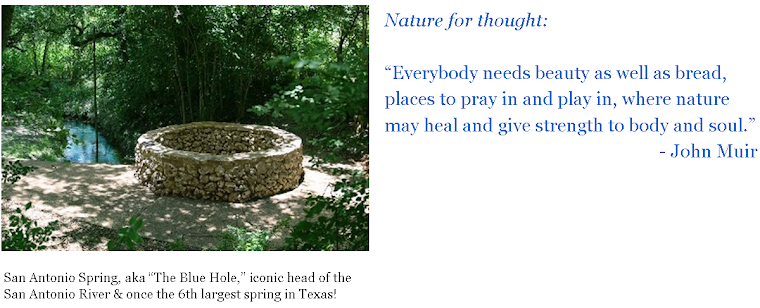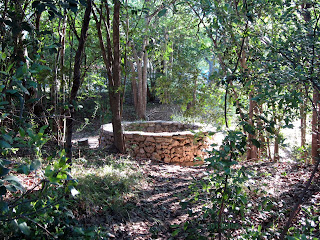I'm happy to say there are a few echoes in this Preface with the Pope's Encyclical on the Environment, released today. This piece brings his message home about our human relationship to creation -- especially in this special place at the head of the San Antonio River that has been entrusted to our care... More reflections to come on the Pope's powerful message.
PREFACE
The Water & Culture Reader (2011)
Fountainhead Press, compiled &
edited by UIW English Department
At the Congregational home of the
Sisters of Charity of the Incarnate Word (San Antonio) is a famous artesian spring
known as the San Antonio Spring, or more commonly the Blue Hole. To indigenous peoples, the springs were
called Yanaguana, which in the
Coahuiltecan language of these earliest Texans means Spirit Waters, or
up-flowing waters of the Spirit. Native
American creation stories describe how Yanaguana
rose up giving birth to all Creation.
The Spirit Waters were the source of all being, which helps explain why Yanaguana is the most oft sung word in
the Native American Church.
1764 Map of San Antonio showing the
San Antonio Spring as the source (labelled Ojo de Aqua at far left)
Whether you see these Great
Springs pragmatically and hydrologically as the headwaters of rivers that
became the lifeblood of thriving cities, or as Yanaguana – up-flowing Waters of the Spirit, Source of all Creation
-- these Great Springs have had enormous cultural and spiritual significance to
people over many thousands of years: pre-historic First Americans, Spanish
explorers, early European settlers, citizens of the 21st century. But what of the future?
While the Blue Hole and much of
the San Antonio River headwaters are now “protected” in the 53-acre Headwaters
Sanctuary (created in 2008 by the Incarnate Word Sisters who have lived in the
headwaters since 1897), there is little doubt the San Antonio Springs are
endangered.
Sadly, today, and plain for all to
see, the Blue Hole is dry. This
“overpowering” spring has not flowed since 2011. Exceptional drought and more disturbingly a
growing human population dependent on groundwater withdrawals have literally sucked
dry this once prolific spring. The Blue
Hole -- lifeblood of the city with the river running through it – has at least
for now retreated into the dark womb of the Earth from which it came.
What might this tell us about the
condition of our human relationship to the Earth and Earth’s resources on which we depend for our very survival? What might it tell us about the state of our
human relationship to the rest of Creation?
Today, 2.5 billion people live in
countries with moderate to severe water stress.
Over 1 billion people lack access to clean water. 2.6 billion lack adequate sanitation.


As Earth’s climate is undeniably and devastatingly altered, and as Earth’s life-giving, life-sustaining resources are extracted and consumed by the world’s ever growing population...
...as the Earth itself is crying out for relief at our hands...
When water is unfit
to drink, air is unfit to breathe, soils wash out to sea, landfills leak toxins,
forests disappear, species go extinct, oceans inundate coastal zones, agriculture
fails, habitat fragments, hurricanes terrorize, rock formations “frack,” when wars
are fought over oil and increasingly over water, we must conclude that the
Earth and our relationship to it is horribly out of balance. How are we to face these seemingly overwhelming
challenges of the 21st century?
It’s easy to despair, to turn our thoughts to technological fixes.
But we mustn't despair, despite the evidence, or look only to science and technology for
answers. As we endlessly debate and seek
political solutions, as we innovate and create new technologies, as we learn to
cooperate and pool our global resources, each of us must also attend to that
underlying spiritual challenge, asking ourselves how we are going to live in sustainable relationship with the Earth and each other. How must we live to be in right relationship with the Earth, and all creation? How can
we heal this broken relationship that gives rise to so much suffering and
injustice?
I'm now convinced that wrestling with these questions is a matter for the human heart, and it is the work of the Spirit that dwells within and among us and all Creation.
Are we
listening?
Are we alive? Alive enough to care?
Will we
respond?!
Here’s a thought: Go find your patch of the Earth, and “dig in.” For the Earth’s sake, and for your own. If you are open to it, you will find food for the soul, and spiritual sustenance from working the land respectfully, working to care for the Earth. You will show others the way. Take seriously all the many ways we each can use less energy and water, create less trash, teach our children, let them teach us, and become more mindful of the needs of others, in both our local and global community.
It is place to teach the children.
With healing hands and loving hearts, people are nursing
this sacred place to ecological health, and in our own little, localized way,
we are restoring right relationship within ourselves, with the Earth, and all creation. We are paying
tribute to Yanaguana, place of the up-flowing
Spirit Waters. And praying for the rains
that will give life again to these sacred springs....praying that all of us will learn to live well with less, especially water.
We are clearly being called to WAKE UP! Let’s not turn a deaf ear. Instead, let’s:
Tend to the
Earth.
Tend to each
other.
Evolve.
For if we do not,
we humans may pass from this earth as surely as the dinosaurs.
Nature will have her way.
Nature will have her way.
Believe in the ultimate resilience
of Nature. Believe in the resilience of Us.
Engage in
cultural (r)evolution.
Emulate the self-healing capacities of Mother Earth.
Embody hope.
Emulate the self-healing capacities of Mother Earth.
Embody hope.
And know this simple truth in
every aqueous cell of your being:
Water is life. Aqua es
vida. Maji ni uhua. 水是生命










































